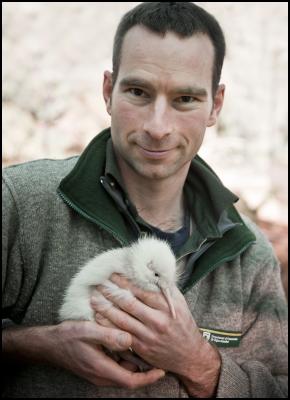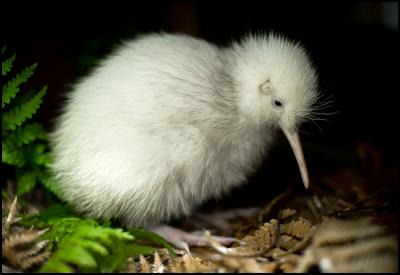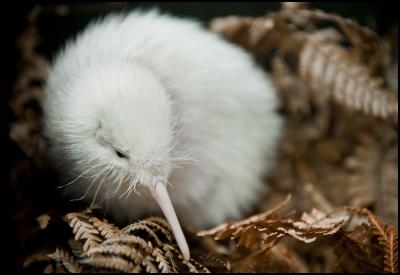White kiwi chick graduates from nursery

Darren Page, Department of Conservation Captive Breeding Ranger at Pukaha Mount Bruce moves his precious charge out of the kiwi nursery and into an outdoor enclosure.
Media information 2 June 2011
White kiwi chick graduates from nursery
Manukura, the white kiwi chick
hatched on 1 May at Pukaha Mount Bruce, yesterday got its
first feel for the outside world when it graduated from the
centre’s kiwi house nursery to an outdoor enclosure in the
forest reserve.
After reaching its required weight and all the expected milestones, including eating on its own, the chick was moved to a predator-proof enclosure in the Pukaha native reserve where 12 other chicks have been raised this season.
Manukura was the 13th of 14 kiwi chicks hatched at the National Wildlife Centre this breeding season, the most successful there ever. The 14thchick remains will remain in the kiwi house nursery for the next week.

Thought to be the first white kiwi chick hatched in captivity, Manukura will remain in the outdoor enclosure for the next 4-6 months subject to its behaviour and welfare. Visitors to the centre will be able to see the special kiwi each Sunday at 2pm after he has been weighed by Department of Conservation (DOC) rangers.
When the fertile egg was retrieved from the Pukaha native forest and brought into captivity with others to be incubated and hatched, DoC staff at the national wildlife centre had no inkling as to what was inside. When he saw the white chick hatch, captive breeding ranger Darren Page said his first thought was “oh this one’s going to create a stir.”
Pukaha Mount Bruce manager Kathy Houkamau said staff excitement and global interest in Manukura had been matched by that of visitors on seeing the white chick. “We have had good crowds through over the past week and people have been genuinely thrilled to have the opportunity to see it. People see it as a sign of good things.”
A Facebook page to track Manukura’s progress has been set up by the centre.

Two of this season’s chicks have already been released into the 940-hectare native forest and the remaining chicks will be released over the next few months as they reach the required weight. However, Department of Conservation (DOC) rangers, who manage the kiwi programme at Pukaha, will ensure the best interests of Manukura remain a priority.
“We want to ensure that as many people as possible get a chance to see it, and that we keep it as safe as possible,” said DOC area manager Chris Lester. We also recognise the need to take everything into account when deciding Manukura’s future.”
Named Manukura by local iwi Rangitane o Wairarapa, the chick is not an albino but the rare progeny of kiwi that were transferred to Pukaha from Hauturu/Little Barrier Island last year.
Rangitane chief executive and Pukaha Mount Bruce board member, Jason Kerehi, said tribal elders saw the white chick as a ‘tohu’ or ‘sign’ of new beginnings. “Every now and then something extraordinary comes along to remind you of how special life is. While we’re celebrating all 14 kiwi hatched this year, Manukura is a very special gift.”
ENDS
Background information
• The restoration of the native 940-hectare Pukaha forest began in 2001 with the aim of returning the dawn chorus to the area through the reintroduction into the wild of endangered native birds.
• The success of the pest control effort enabled the reintroduction of kokako and kiwi into the unfenced reserve in 2003. Kokako and kiwi had been absent from the area for 60 and 100 years respectively. Since the 2003 releases, kiwi, kokako and kaka have successfully bred in the wild.
• Pukaha Mount Bruce is under the guardianship of a partnership between Rangitane o Wairarapa, the National Wildlife Centre Trustand the Department of Conservation. These groups were drawn together along with co-opted members of the local community in partnership through the Pukaha Mount Bruce Board which was established in 2006.
• The Department of Conservation undertakes day-to-day management and forest restoration programme of Pukaha Mount Bruce on behalf of the Board.
Pest control at Pukaha Mount Bruce
• The 940-hectare Pukaha sanctuary is protected by more than a 1,000 traps which are regularly monitored. 800 of these are in the regional council buffer zones on farmland surrounding the reserve and 200 are in the reserve, mostly at the perimeters where predators generally try to gain access.
• The Pukaha Mount Bruce Board has
the task of raising $150,000 per year to keep pests out of
the forest. These funds are largely raised through
community fundraising, and grants and donations from
supporters.


 Stats NZ: Retail Spending Flat In The September 2024 Quarter
Stats NZ: Retail Spending Flat In The September 2024 Quarter Antarctica New Zealand: International Team Launch Second Attempt To Drill Deep For Antarctic Climate Clues
Antarctica New Zealand: International Team Launch Second Attempt To Drill Deep For Antarctic Climate Clues Vegetables New Zealand: Asparagus Season In Full Flight: Get It While You Still Can
Vegetables New Zealand: Asparagus Season In Full Flight: Get It While You Still Can  Bill Bennett: Download Weekly - How would NZ telecoms cope with another cyclone
Bill Bennett: Download Weekly - How would NZ telecoms cope with another cyclone NZ On Air: Firm Audience Favourites Lead NZ On Air Non-Fiction Funding
NZ On Air: Firm Audience Favourites Lead NZ On Air Non-Fiction Funding Insurance and Financial Services Ombudsman: Woman Gets $40k More After Disputing Insurer’s Decision
Insurance and Financial Services Ombudsman: Woman Gets $40k More After Disputing Insurer’s Decision



